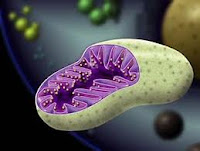development: is all the changes that occur as a living thing grows.
consumer: are living things that eat, or consume, other living things.
producer: are living things that make, or produce, their own food.
cellular respiration: is the process by which food is broken down and energy is released.
adaptation: a trait that makes living things better able to survive.
cell membrane: gives the cell shape and holds the cytoplasm.
nucleus: is the cell part that controls most of the cell's activities.
nuclear membrane: is a structure that surrounds the nucleus and separates it from the rest of the cell.
nucleolus: is the cell parts that helps make ribosomes.
chromosomes: are cells parts withh information that determines what traits a living thing will have.
cytoplasm: jellylike material between the cell membrane and the nucleus that makes up most of the cell.
ribosomes: are cells parts where proteins are made.
mitochondria: are cell parts that produce energy from food that has been digested.
vacuole: is a liquid-filled space that stores food, water, and minerals.
centrioles: are cell parts that help with cell reproduction.
chloroplast: are cell parts that contain the green pigment, chlorophyll.
cell wall: is a thick outer covering outside the cell membrane.

























No hay comentarios:
Publicar un comentario